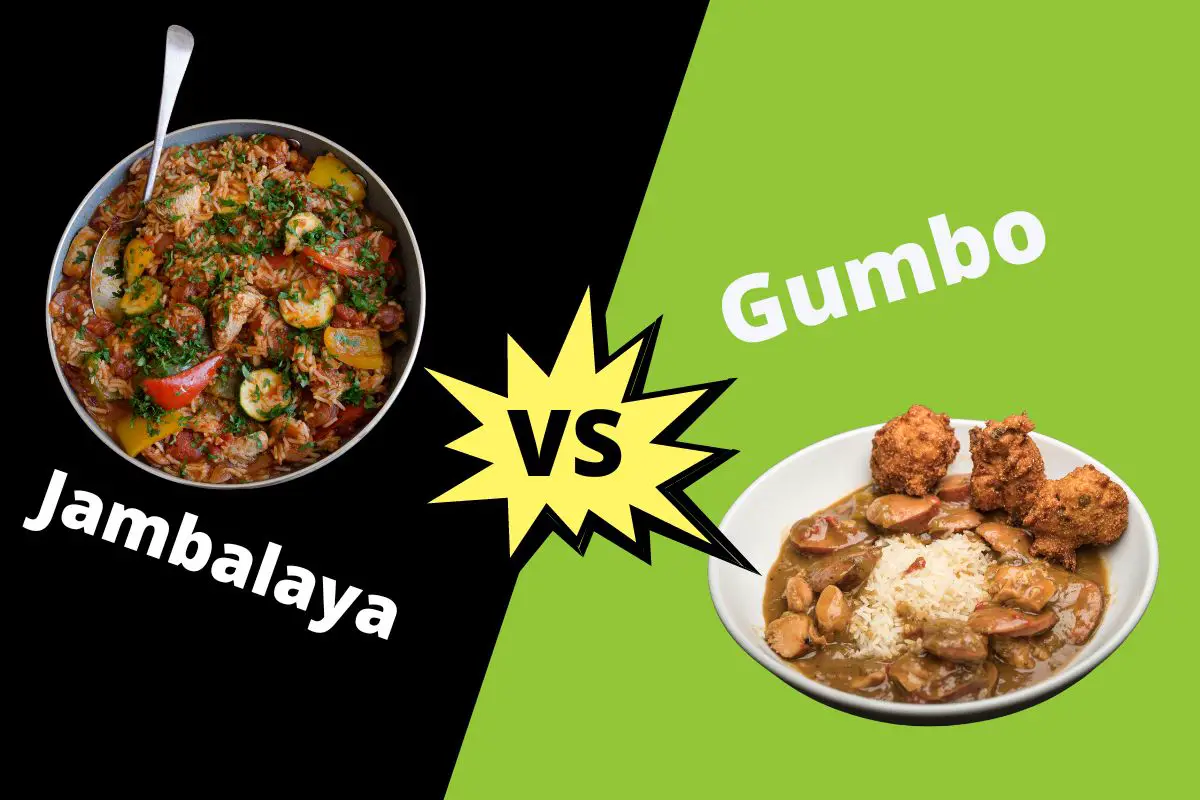The primary difference between gumbo and jambalaya is whether rice is added. Gumbo is a stew that is ladled over rice, while rice is cooked directly in jambalaya.
New Orleans’ trademark rice dishes — gumbo and jambalaya — are among the most loved rice dishes in Louisiana and beyond.
The terms gumbo and jambalaya are often used interchangeably, as they have plenty in common. But, these dishes are not the same thing.
Table of Contents
What is Gumbo?
Made from the Holy Trinity of vegetables, gumbo is a stew served over rice. Thickened using okra, dark roux, and filé powder obtained from ground sassafras leaves, gumbo is a staple dish in creole and cajun cuisines.
While the creole version of the dish contains seafood such as crabs, shrimps, crawfish, and oysters, the cajun version can include chicken, duck, fowl, or sausage.

Gumbo: Origin
Experts trace gumbo’s origin back to the 1700s when African slaves in Southern Louisiana prepared their meals using cooked okra and rice. Local legends suggest it originates from a French dish called bouillabaisse.
Another theory points to the origin of gumbo to Choctaws (Native Americans), who used filé powder as a spice and thickening agent.
What is Jambalaya?
Jambalaya is a one-pot rice dish made from the holy trinity of vegetables, similar to gumbo.
Along with the holy trinity, the dish contains seasonings in addition to garlic, parsley, cayenne, and red pepper flakes. The dish can include your preferred meat choice and is often made with tomato sauce.

Jambalaya: Creole Origin
The dish traces its origins to paella and is similar to the West African Jollof. Creole jambalaya, also known as the red jambalaya, has its roots in New Orleans French Quarter, and Cajun jambalaya, or the brown jambalaya, has its roots in Louisiana’s rural areas. It’s a staple in Creole cuisine.
Gumbo vs Jambalaya
Similarities
Both dishes have made it to the top of the Mardi Gras menu, celebrating New Orleans’ cajun and creole heritage. While the plates have different origins, they are known for sharing some similarities. Let us look at the similarities between the two:
- The holy trinity of vegetables forms the base for both dishes.
- Gumbo and jambalaya are one-pot dishes.
- Both the dishes incorporate similar ingredients.
- Rice is an essential part of both dishes.
Differences
Gumbo and jambalaya have plenty in common, but a few differences make each unique. Let us look at the dissimilarities between the two:
- Gumbo is a thicker stew, while jambalaya has a lesser soupy consistency.
- Gumbo is served alongside rice, whereas in jambalaya, rice is cooked directly with other ingredients.
- Gumbo uses okra and filé powder as a thickening agent. In contrast, jambalaya uses tomato juice/sauce and cornstarch.
- Gumbo requires a longer cook time (around 3-4 hours), whereas jambalaya cooks on a simmer flame for about an hour.
Difference Between Gumbo and Jambalaya
| Gumbo | vs | Jambalaya |
| Southern Louisiana | Origin | New Orleans French Quarter |
| Thicker | Consistency | Thinner |
| Holy trinity, veggies, meat | Main Ingredients | Mix of meat, veggies with rice or shellfish and stock |
| Okra and filé powder | Thickening Agent | Tomato juice and cornstarch |
| Cooked separately and served | Rice | Cooked with other ingredients in the same pot |
What Goes into a Gumbo?
The stew or soupy dish is spooned over rice and usually takes 1.5 hours – 4 hours of cook time. Let’s look at this gumbo recipe for preparing authentic New Orleans Gumbo:
Making The Roux:
- Combine equal proportions of flour and fat in a large pot.
- Stir constantly over medium-low heat for about 25 to 40 minutes.
- Cook until the result is dark brown paste.
Veggies:
- Start by chopping celery, onions, and bell pepper
- Add okra
Meat:
Spread meat on a hot pan and cook until they turn brown.
Add meat and vegetables to the roux and simmer it for several hours.
- Serve warm over hot cooked long-grain rice. You can use white rice if you prefer.
Watch here: How to make New Orleans Gumbo
What Goes into a Jambalaya?
Unlike gumbo, long-grain rice is a critical ingredient in jambalaya. Let us look at the components that make it unique:
The Holy Trinity
Jambalaya also depends on the holy trinity’s seasoning.
Veggies, Meat, And Rice
The dish comprises a mix of veggies and meat, such as andouille sausage, with rice and stock.
While creole jambalaya includes tomatoes in its ingredients, Cajun jambalaya does not, as cajun cuisines do not.
How to Make Jambalaya
Jambalaya is usually prepared under 30 minutes of cook time and in a single pan. Let’s look at the recipe for preparing one pan jambalaya:
- Brown the chicken and sausage in a large pan.
- Remove the browned meat to a plate.
- Add butter and flour to the pan.
- Saute garlic and the holy trinity.
- Add seasoning, cajun, and sugar.
- Add broth, rice, and meat back to the pan.
- Bring the mixture to a boil, and simmer
- Serve hot.
Watch here: How To Make Cajun Jambalaya with Isaac Toups.
Is Gumbo the Same as Jambalaya?
The simple answer is no. The main difference between the two is the consistency and some ingredients, particularly rice, which is integral to both dishes.
The most apparent difference between gumbo and jambalaya is rice use during preparation. While gumbo is a thick stew served with rice, jambalaya is a stew where rice is cooked alongside other ingredients in the same pot.
Nonetheless, both the dishes are flavorsome and will keep us asking for more.

